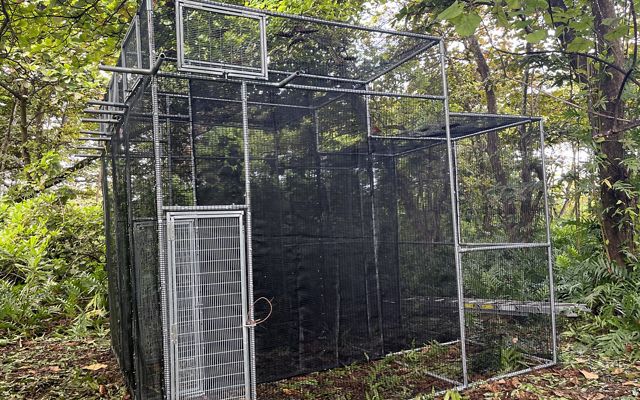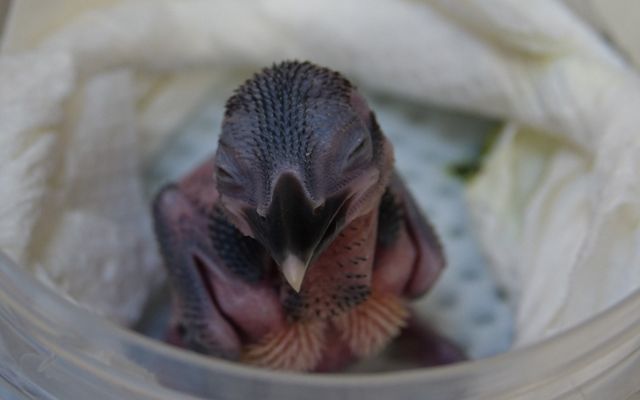Media Contacts
-
Evelyn Wight
Email: ewight@tnc.org
Extinct-in-the-wild sihek, or Guam kingfisher, chicks have successfully hatched and are being reared by expert bird keepers, marking a key milestone in an ambitious project to reintroduce the species into the wild at The Nature Conservancy’s Palmyra Atoll Preserve.
Palmyra Atoll is one of only a few places in the world that is viable for wild introductions because it is protected and predator-free.
“One of the reasons this project is happening at Palmyra Atoll is that it provides suitable habitat that is free from key invasive predators,” says Katie Franklin, island conservation strategy lead with The Nature Conservancy. “Over the last two decades, The Nature Conservancy, the U.S. Fish and Wildlife Service, and many conservation and science partners have safeguarded Palmyra Atoll by removing invasive rats and restoring native habitat. Palmyra’s predator-free, functional ecosystem creates the ideal opportunity to give the sihek a temporary home in the wild.”
Quote: Yolonda Topasna
These beautiful birds haven’t sung in the forests of Guam for more than 30 years, but this exciting moment brings us one step closer to the release of Guam sihek onto Palmyra Atoll.
Known as sihek by the indigenous CHamoru* people, the colorful birds once flourished on the North Pacific Island of Guam. Nearly wiped out by the brown tree snake, which was accidentally introduced in the 1940s, fewer than 150 birds remain, kept alive in wildlife facilities across the U.S.
The introduction of sihek to Palmyra Atoll will give the birds a chance to breed in the wild and grow their population. It will also give the project team an opportunity to learn how the species behaves in the wild. Palmyra will act as a temporary home to build their numbers until they can be reintroduced to a snake-free Guam.
“We’re all thrilled that this year’s first chick has hatched and is doing so well,” says Yolonda Topasna, Guam Department of Agriculture’s Division of Aquatic and Wildlife Resources. “These beautiful birds haven’t sung in the forests of Guam for more than 30 years, but this exciting moment brings us one step closer to the release of Guam sihek onto Palmyra Atoll—a pivotal step toward the eventual reintroduction of this stunning creature to Islan Guahan.”


The first female chick being reared and the second recently born (sex as yet unconfirmed) chick make up the beginnings of a cohort of up to nine siheks that will be released together at Palmyra Atoll later this year. In the coming weeks, sihek eggs will continue to be monitored and chicks reared if they hatch. Once at the atoll, the birds will be raised in aviaries, overseen by TNC and partner scientists until they are ready to be released onto the atoll. This process will be repeated annually until 20 sihek breeding pairs have been successfully established.
This work is being done through the Sihek Recovery Program, a global collaborative of conservationists dedicated to recovering the sihek.
“Returning species to the wild is a long, carefully planned journey built upon global scientific expertise,” says Professor John Ewen, ZSL’s Institute of Zoology and Sihek Recovery Program Team chair. “Siheks deserve a chance to flourish in the wild once again—and it’s well worth taking our time to get it right.”
An Instagram contest named the first chick Tutuhan, which means start or begin, in CHamoru. An Instagram contest at @KUAMNEWS allowed people to vote on other chick names provided by people connected to Guam. The second chick has been named Ahani, which means morning.
###
*“CHamoru” (capitalizing “CH”) is recognized by the CHamoru Language Commission as the orthographically correct spelling. The CHamoru people refer to the Guam kingfisher as sihek.
The Nature Conservancy
A global non-profit organization dedicated to conserving the lands and waters on which all life depends, The Nature Conservancy works in more than 70 countries and territories using a collaborative approach. Informed by science and guided by traditional values and practices, we apply innovative, nature-based solutions to our world’s toughest challenges so that nature and people can thrive. TNC has forged partnerships to manage 14 preserves and other sites in Hawai‘i and Palmyra Atoll, working with government, private parties and communities to protect Hawai‘i’s and Palmyra’s forests and coral reefs for their ecological value and for the many benefits they provide to people. Visit our Palmyra Atoll page.
The Sihek Recovery Program
The Sihek Recovery Program is a global collaborative of conservationists dedicated to recovering one of Guam’s most iconic native species, the sihek (Guam kingfisher, Todiramphus cinnamominus). The Sihek Recovery Program is made up of partners from the following organizations: U.S. Fish & Wildlife Service (USFWS), Guam DAWR, Zoological Society of London (ZSL), The Nature Conservancy (TNC), Sedgwick County Zoo, AZA and the International Union for the Conservation of Nature (IUCN).
The Nature Conservancy is a global conservation organization dedicated to conserving the lands and waters on which all life depends. Guided by science, we create innovative, on-the-ground solutions to our world’s toughest challenges so that nature and people can thrive together. We are tackling climate change, conserving lands, waters and oceans at an unprecedented scale, providing food and water sustainably and helping make cities more sustainable. The Nature Conservancy is working to make a lasting difference around the world in 81 countries and territories (40 by direct conservation impact and 41 through partners) through a collaborative approach that engages local communities, governments, the private sector, and other partners. To learn more, visit nature.org or follow @nature_press on X.
